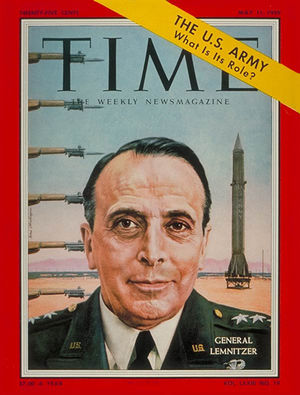Lyman Lemnitzer
(soldier) | ||||||||||||||||||||||||||||||||||||||||||
|---|---|---|---|---|---|---|---|---|---|---|---|---|---|---|---|---|---|---|---|---|---|---|---|---|---|---|---|---|---|---|---|---|---|---|---|---|---|---|---|---|---|---|
 | ||||||||||||||||||||||||||||||||||||||||||
| Born | 1899-08-29 Honesdale, Pennsylvania, U.S. | |||||||||||||||||||||||||||||||||||||||||
| Died | 1988-11-12 (Age 89) Washington D.C. | |||||||||||||||||||||||||||||||||||||||||
| Nationality | USA | |||||||||||||||||||||||||||||||||||||||||
| Member of | Committee on the Present Danger/Members, PIAB, Rockefeller Commission | |||||||||||||||||||||||||||||||||||||||||
| Perpetrator of | Operation Northwoods | |||||||||||||||||||||||||||||||||||||||||
The Chairman of the JCS who approved the now infamous Operation Northwoods, later made NATO's Supreme Allied Commander Europe; was in favor of excessive use of the nuclear arsenal to destroy the Soviet Union.
| ||||||||||||||||||||||||||||||||||||||||||
Lyman Lemnitzer wsa a US soldier, Chairman of the Joint Chiefs of Staff in the early 1960s, when he approved Operation Northwoods, a false flag terror attack against US citizens. This was rejected by JFK. In 1963, Lemnitzer was made Supreme Allied Commander Europe for over 6 years.
Contents
Career
Operation Northwoods
In 1962, as Chairman of the Joint Chiefs of Staff, Lyman Lemnitzer approved the Operation Northwoods, a plan to discredit the Fidel Castro's government and create support for a US invasion of Cuba by staging false flag "terrorism" and developing "a Communist Cuban terror campaign in the Miami area, in other Florida cities and even in Washington". President Kennedy rejected the plan and a few months later Lemnitzer was denied another term as JCS chairman.
Richard Cottrell in his book: Gladio: NATO’s Dagger at the Heart of Europe, notes:[1]
JFK emerged from the crisis with his prestige vastly enhanced, everywhere, that is except 'Pentagonia'. Kennedy's refusal to snuff out Castro and worse, permitting the United Sates to be humbled in the world arena by the Soviet Union, united them once again under Lemnitzer's authority. The danger to the head of state returned with renewed intensity. Barely had the heat of the immediate emergency cooled than Kennedy struck with an iron fist. He decided on a clever 'constructive dismissal' of bis troublesome commander. Lemnitzer would be denied his due right of a second term of office as chief of the staff, effectively cashiered, and given his marching orders right away. A humiliating demotion would be disguised, somewhat at any rate, by secondment to the top NATO command in France. If it was a signal that Kennedy intended to stop the rot in the military, then his decision to install his court favourite, General Maxwell Taylor, in Lemnitzer's stead, could only be seen as another calculated insult. It was a Solomonic judgement in which Kennedy excelled, like his calm resolution of the Missile Crisis. Sending Lemnitzer into quarantine on the other side of the Atlantic, in charge of America's frontline with the Russians, his mischievous hands would be too preoccupied to plot trouble on the home front. Deprived of Lemnitzer's presence in Washington, trouble in the ranks would gutter out. Kennedy miscalculated, badly, on both counts.
Of all the juries that have probed the deaths of John and Robert Kennedy, official and informal, none have expressly pointed the finger of suspicion at General Lemnitzer. Yet if one man had the motive and desire to see the brothers off the scene, commencing with the president, then it was a soldier in the grip of hatred so powerful that any lengths were acceptable. Northwoods and its offshoots demonstrated that he regarded morality in the defence of American interests as a distraction. Here was a man who would enlist Mafia hoodlums in the service of his objectives. He cheerfully waved volunteers off to certain death in the Bay of Pigs fiasco. He planned to unleash terror on innocent Americans going about their everyday business so that he could get his way over Cuba. He contemplated extinction of a quarter of the human race — and very possibly life itself — with magnanimity. He hired Nazi war criminals with equanimity. He was not alone in that, but gave every impression of complete disinterest in their crimes against humanity, which he brushed off like dandruff.
When he got to Europe, this highly political animal in uniform found at his disposal a vast military apparatus — almost as big as any such plaything at home. Moreover, he had the splendid bonus of the secret armies — with which he could wreak havoc all over the continent, and did. The Lemnitzer years in Europe were warped by the descent into institutionalised state violence wrought against sovereign governments and their citizens. Lemnitzer shamelessly hoisted the black flag of terror over Europe. True it was already furled and waiting for him, but no other commander in chief of the Allied forces in Europe would find a better purpose for it than the most supremely ideological general the United States has produced.
[...]
Lemnitzer was behind the schemes to murder President Charles de Gaulle, with the aid of disaffected Algerian veterans, Hungarian dissidents and Gladio guerrillas.
NATO
In 1963 he became NATO's Supreme Allied Commander Europe. During his term, in 1966, the Bilderberg reorganised NATO such that the NATO Secretary General has always been appointed to a Bilderberg member.
Bilderberg
Lemnitzer attended the Bilderberg.
An event carried out
| Event | Description |
|---|---|
| Operation Northwoods | A plan devised within the US government in the early 1960's to carry out terrorist attacks on US citizens and have them blamed on Cuba. Never implemented. Some parts are eerie similar to the first few hours of 9-11. |
Event Participated in
| Event | Start | End | Location(s) | Description |
|---|---|---|---|---|
| Bilderberg/1963 | 29 March 1963 | 31 March 1963 | France Cannes Hotel Martinez | The 12th Bilderberg meeting and the second one in France. |
References
- ↑ 2015 revised edition, ProgRESSive, page 101, 102